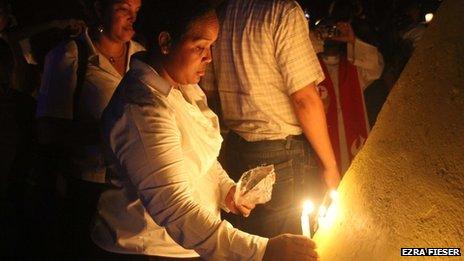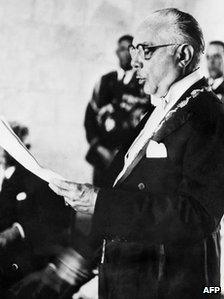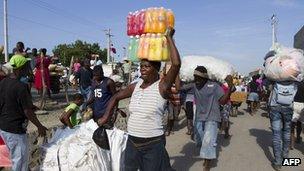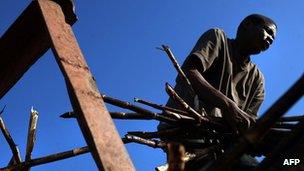The massacre that marked Haiti-Dominican Republic ties
- Published

Both communities have come together to mark the anniversary
Seventy-five years ago, the border between Haiti and the Dominican Republic was the scene of a mass slaughter that has long burned in Haitians' collective memory but was either unknown or forgotten in the wider world.
It earned the name the Parsley Massacre because Dominican soldiers carried a sprig of parsley and would ask people suspected of being Haitian to pronounce the Spanish word for it: "perejil".
Those whose first language was Haitian Creole found it difficult to say it correctly, a mistake that could cost them their lives.
Historians estimate that anywhere between 9,000 and 20,000 Haitians were killed in the Dominican Republic on the orders of the Dominican dictator Rafael Trujillo.
Bodies were dumped in the Massacre River, ominously named after an earlier colonial struggle between the Spanish and French.
The killings of 1937 changed the relationship between the two countries on the island of Hispaniola and its effects can still be felt today.

Rafael Trujillo was in power from 1930 until his assassination in 1961
From late September to mid-October that year, men, women and children were rounded up, then beaten or hacked to death for just being Haitian.
Even dark-skinned Dominicans were caught up in the purge that became known as "el corte", the cutting.
Haitian migrants had for generations crossed the informal border region in the north of the island to work as labourers in the sugar plantations of the Dominican Republic.
But during the Great Depression the country's economy began to slump and immigrants became the scapegoat.
US diplomatic cables at the time described the killings as "a systematic campaign of extermination".
The US administration regarded Trujillo as a staunch ally but after the scale of the massacre emerged, President Franklin D Roosevelt's administration made the Dominican Republic pay reparations to the victims' families - money that ultimately never reached its intended recipients.
There is evidence that in many villages Dominicans risked their own lives to help their Haitian neighbours escape.
But in other cases, local people pointed out Haitian immigrants to the authorities.
Shared history
Today, the border is officially open on Mondays and Fridays.
The bridge that connects the town of Dajabon on the Dominican side and Ouanaminthe in Haiti is a sea of people carrying goods to market.
The two towns, filled with the sounds of Spanish and Creole, depend on each other.

Trade between Dajabon and Ouanaminthe on the Haitian side is crucial to both towns
"We have more in common than the differences. Trujillo tried to rid the Dominican Republic of its Haitian roots but our cultures and lifestyle are very similar," says Lesly Manigat, a Haitian doctor living in the Dominican town of Santiago.
"The French, the Spanish, the Africans, it's a shared history."
Dr Manigat belongs to a group called Border of Lights that has been marking the anniversary by using art, poetry and social action to bring the communities together.
Church services were held in both towns to remember the dead, and people took part in a candlelight vigil, marching to their respective border fences.
Distant voices of support could be heard as flickering tea lights floated down-river.
There were some, however, who felt that too much time had passed. In the Dominican newspapers, there was concern that marking the event may raise tensions.
But organisers of the commemorations said it was important to remember.
"People have described it as 75 years of silence and this is a chance to talk about it because these wounds are still in us and so we don't repeat the past," said Cynthia Carrion.
Joint efforts
However, attitudes marked by the past still haunt both countries.
It is estimated than more than a million illegal Haitian migrants live in the Dominican Republic, and in Dajabon, people-smuggling is rife.

Many Haitians seek work in the Dominican Republic
"After 1937, the Dominican culture became exclusive. On a local level people could work together and could accept that we have a society that's mixed, of which Dominicans of Haitian descent are a part," said Dr Edward Paulino, a Dominican-American member of Border of Lights.
"But at the state level there's still this sense of rejection of dark-skinned Haitians."
Recently it was alleged that a Haitian worker in a town near the border, Loma de Cabrera, had killed a Dominican.
Local people told the Haitians to leave within 24 hours.
But many of those taking part in the events to mark the massacre spoke of the unity that exists between people on the border.
"We did a park clean-up on the Haitian side. One of the volunteers couldn't believe we'd come to help his community and I realised that this was a first," said Sady Diaz, one of the organisers.
People in both towns will be coming together again later in the month to paint murals along the border, a lasting tribute to those who died.
- Published28 May 2011
- Published9 July 2024
